Ultimate Guide to Business Process Mapping: Definition, Examples, 8 Steps and Tips
Reading Time:
11
minutes
With businesses growing at the speed of light, it’s become apparent that many processes and functions are working to keep the business running smoothly. To understand how these organizations function, it’s important to understand how the processes work across departments and teams. This is where process mapping comes in. Process mapping can help you understand a process down to its fundamentals, which can help you further improve efficiency and productivity.
Mục Lục
What is Process Mapping?
Process mapping is a tool that creates a visual depiction of a process. This tool can help with planning and management throughout your organization as you can clearly depict processes across all departments. A business process is a series of tasks or events that can lead to a finished product or service for the end consumer. These business processes exist in every department and involve coordinating people, departments, software, and data across the organization.
Breaking down each step of a business process can help you get a good look into the process’s inner workings. By analyzing every step of the process, you can also understand the strengths and weaknesses of each step of the process, identify potential bottlenecks, and understand the people involved with the process on the whole. Improving upon existing processes also becomes easier once you know the process completely and thus helps with enhancing productivity.
Process mapping must include the inputs, existing steps of the process, and outputs to create a holistic view of the purpose and efficiency of the process.
Business Process Mapping Symbols
The workflow must be clearly depicted along multiple paths, decision-based directions, or rework loops. The process can be depicted using a variety of symbols.
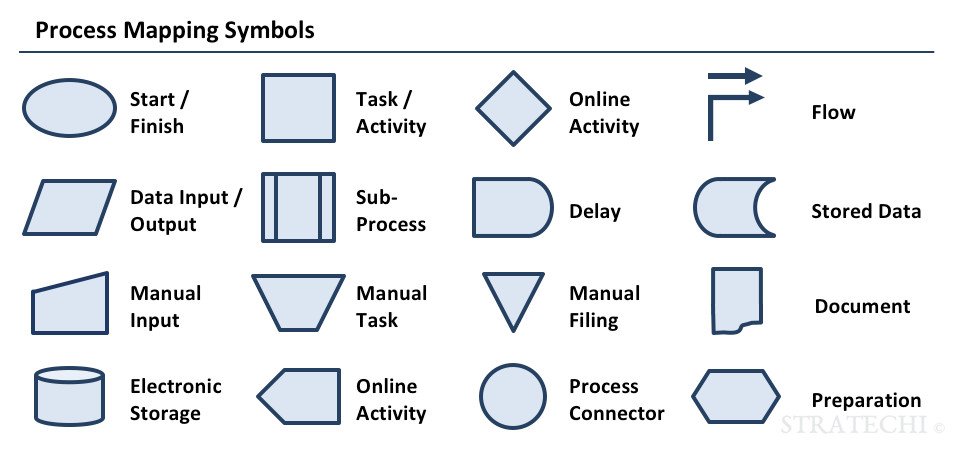 Source: Stratechi
Source: Stratechi
Process mapping is also a part of BPM. Business process management (BPM) is a process that involves examining and refining existing to make them as efficient and effective as possible. This includes discovering, modeling, analyzing, measuring, improving, and optimizing organisational processes.
Process mapping can help you define the process in different departments, including Service Desk, Human Resources, Recruitment, Procurement, Customer Onboarding, etc. For example, in your Service Desk department, automating the workflows requires clear processes that can be followed in the event of any scenario. After the user submits a request, this request is moved on to the next step and the concerned individual and then assessed further. After the issue is resolved, the user is informed, and the request is closed out. To ensure this activity goes smoothly, the process must be mapped out entirely.
Also read: 5 No-Code Ways to Upgrade Automated Workflows
Types of process maps
Process maps are the visual depiction of a process along with the tasks in the process and the roles that are involved. There are multiple types of process maps including:
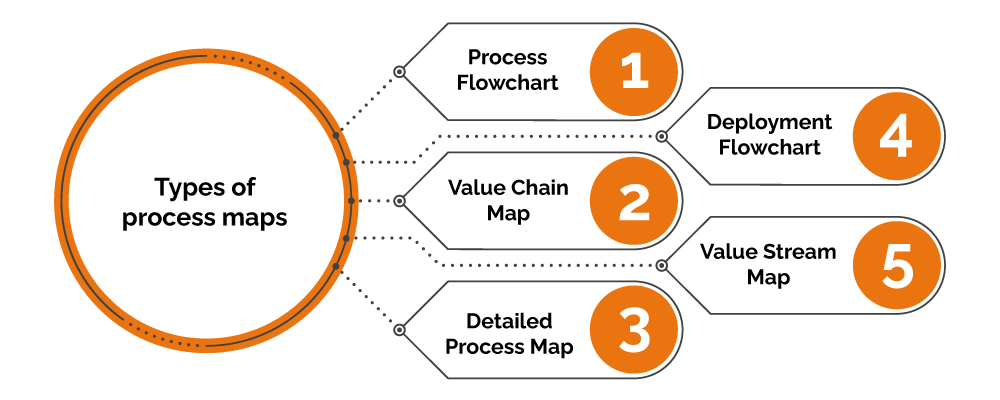
1. Process Flowchart
A simple flowchart detailing a process’s steps, inputs, and outputs.
 Source: ConceptDraw
Source: ConceptDraw
2. Value Chain Map
A map that shows the core tasks in processes without going into too much detail regarding roles or rework loops.
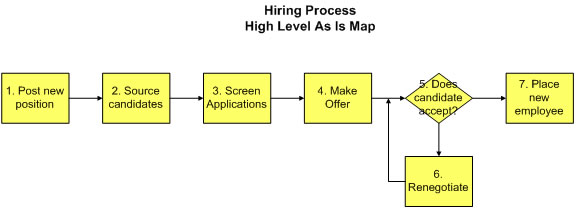 Source: BPMInstitute.org
Source: BPMInstitute.org
3. Detailed Process Map
A map containing all of the details of sub-processes and decision points within a process.
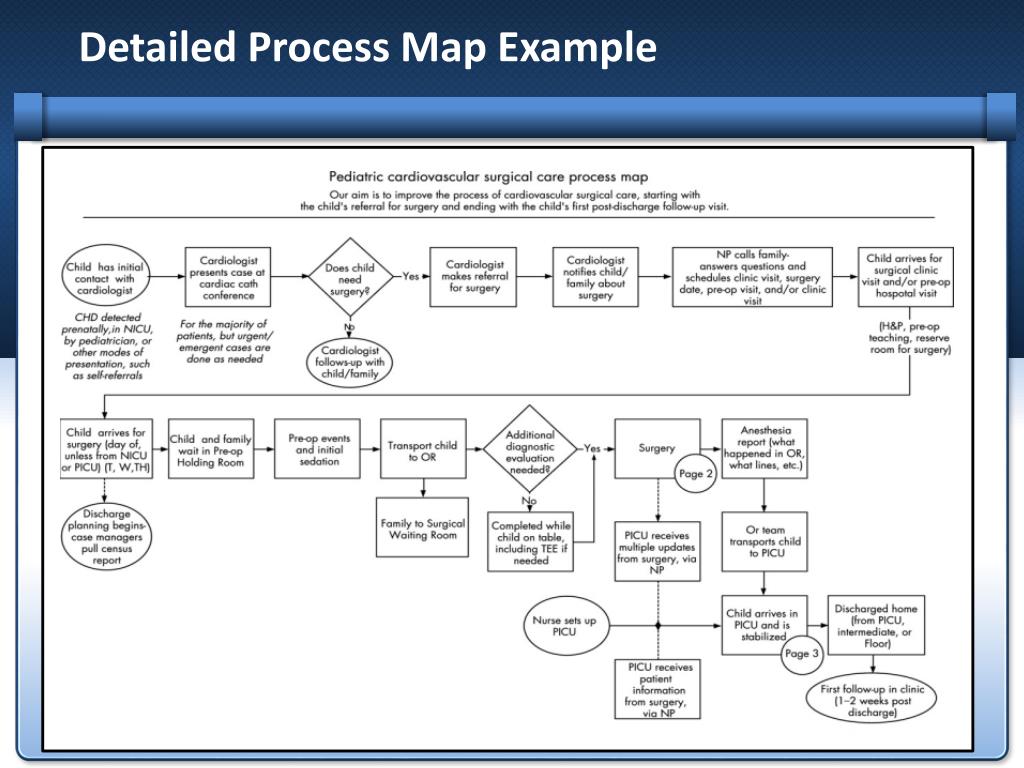 Source: SlideServe
Source: SlideServe
4. Deployment Flowchart
A map showing the relationship between the tasks in each step and the units responsible for them. They are also known as swim-lane charts.
 Source: Creately
Source: Creately
5. Value Stream Map
A map showing the materials and data needed to deliver the final output to end consumers. These maps use a specific, defined set of symbols to show a process.
 Source: Creately
Source: Creately
What are the benefits of process mapping?
Process mapping helps lay out a process’s fundamentals in a clear visual format. This prevents any potential confusion regarding the people concerned and the tasks that need to be completed. A process map also helps show the path to solving a problem and providing some product or service to the end consumer.
Businesses often focus on efficiency and productivity and process mapping can help you analyze your business processes on these parameters. Here are a few more ways in which process mapping can help your business:
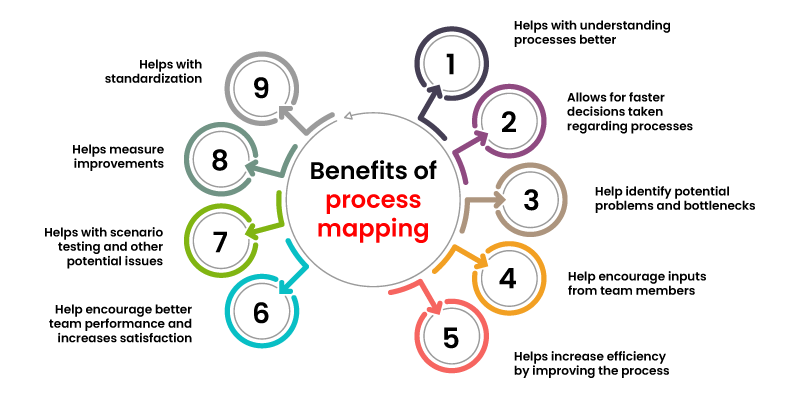
1. Helps with understanding processes better
While creating a process map, you use graphical elements like images, graphs, charts, tables, flowcharts, and mind maps which are easier to understand at a glance. Large text-heavy reports can become difficult to comprehend and tedious to get through, so process mapping can speed this up. Since the processes are depicted visually, it’s easier for employees in teams, stakeholders, and other concerned individuals to understand who’s involved and the steps in the process. Process mapping also helps make process documentation more reader-friendly and increases comprehension of the roles and responsibilities of those involved.
2. Allows for faster decisions taken regarding processes
Images are processed by the brain 60,000 times faster than words or blocks of text, so visually depicting processes aids comprehension. Process mapping can help employees understand the process at a glance. Showing someone a process is much faster than explaining a process to someone in words. Thus, decisions can also be taken much faster regarding any problems.
3. Help identify potential problems and bottlenecks
Laying out the process in an easily understandable format can help identify issues and obstacles within the process. The obstacles might cause delays and loss of time and money in the organization, so it’s easier to nip these problems in the bud if you completely understand their purpose within the process. This will make the process smoother on the whole as well.
4. Help encourage inputs from team members
Creating a visual representation of a process allows for an unfiltered view of each step of the process. Process mapping makes it easy for employees to come up with potential improvements in the process, leading to innovative solutions and tasks to pinpointed problems. Tackling challenges can become easier if the team can brainstorm together and fix problems like retaining employees or customer dissatisfaction.
5. Helps increase efficiency by improving the process
Process mapping helps you understand the inner workings of a process. If a change is made without understanding the process, there are more chances of issues and mistakes when the process is put in motion. Thus, process mapping can give a detailed outlook of the process and changes can be adapted to fit the process better. Process mapping can help you break down the inefficient parts of a process and replace those steps with a better task or activity. This can increase the efficiency on the whole leading to better productivity.
6. Help encourage better team performance and increases satisfaction
When each member has a comprehensive understanding of their roles and responsibilities within a process and their team member’s responsibilities, this can prevent conflicts and confusion during a project. Clearly defined processes can make it easier for new employees to understand their daily tasks and responsibilities, leading to more efficient onboarding processes.
7. Helps with scenario testing and other potential issues
Process mapping can help with testing out potential scenarios under different circumstances. This is beneficial in case of any obstacles or changes in the environment when this process is followed, as a backup plan can be created efficiently. What-if assessments can also be conducted efficiently.
8. Helps measure improvements
Process mapping also helps keep track of the changes and improvements that have been made to the process. Auditing and understanding the individual steps of a process is much easier, leading to better improvements and a chance to measure the efficiency of the process and track progress.
9. Helps with standardization
When employees are given a clear, standardized method to tackle a problem, they’re more likely to come out with standard output. Process mapping can help spur this on by creating a standard process map for employees to follow in the future. This can also lead to better efficiency and productivity throughout the department as each employee will know their role in the process and what will happen going forward. Process maps can also dispel confusion as the employees will consistently know the next step to take to get the best results.
Also read: The Complete Guide to the Approval Process and Workflow
![]()
How can you start process mapping?
We’ll use an example of the hiring process to explain how to create a holistic process map. You can follow these steps:
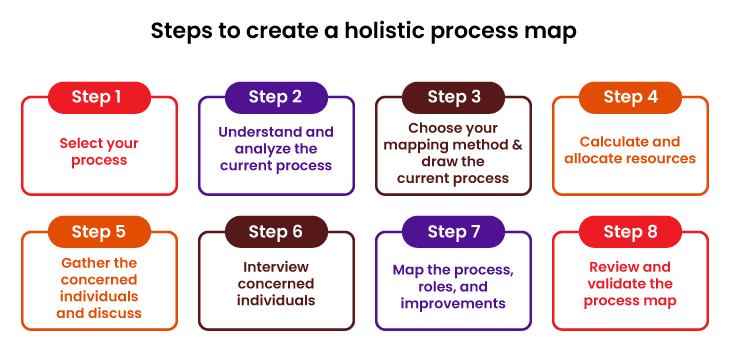
Step 1: Select your process
Identify the process that you need to understand properly. Also determine the issue that you hope to solve with this exercise whether its underperformance, importance for a new strategy, wastage of resources, etc.
Eg. The process for hiring a new employee.
Step 2: Understand and analyze the current process
Get a clear idea of the beginning and the end of the process to start with. The beginning will be the events that trigger this process as well as create demand for the finished product. The end includes the parameters that define the successful completion of the process. Collect data regarding the scope of the process, the individual steps within the process currently, the resources required for this process, the concerned individuals in this process, and the input and output associated with the process.
Eg. Understand who triggers the hiring process – a business leader with a new requirement. Track who is involved in the process further and how the process can be deemed completed successfully – the successful hiring of a new employee and a smooth onboarding.
Step 3: Choose your mapping method and draw the current process
Based on all of the information so far, draw up a basic rough version of your current process. There are several mapping methods for process mapping like process flowcharts, deployment charts and more so it’s important to choose the correct technique. Once you visually depict the current process, start examining it to identify the concerned individuals and roles.
Eg. You can choose the simple process flowchart method to show a straightforward hiring process or the deployment chart to show how the different roles are involved in the hiring process.
Step 4: Calculate and allocate resources
Based on your understanding of the previous steps, identify the roles associated with the process. The manager or business leader who is conducting this exercise needs to be very process-oriented when creating this process map, which requires a greater focus on the roles of the employees instead of their jobs. Defining time management and the responsibilities and roles of employees needs to be taken care of during this step. Understand how your resources are being used in every step of this process.
Eg. In the hiring process, the business leader with the requirement, the hiring manager, and human resources department will all be involved.
Step 5: Gather the concerned individuals and discuss
Get in touch with all of the concerned individuals that were identified in the last step and let them know that the process is going through an overhaul. These employees may prove invaluable as they’ll have in-depth insights regarding the inner workings and failings of the process.
You also need to get in touch with the people who provide the triggers to get this process started in the first place. Take the inputs of all of these individuals to make sure that you’re on the right track and not creating even bigger problems with this exercise. Understand how the process that’s on paper differs from the one that is put into practice. Explain the current process map to them step-by-step as well as the links between each step.
Eg. Speak to the concerned individuals to understand how the process usually works in terms of time management and other parameters. Figure out if they have any issues during the normal process and how they think these issues can be resolved.
Step 6: Interview concerned individuals
As an optional step, you can conduct interviews with the concerned individuals based on the sequence of roles within the process, if you need further insights regarding the process. Ask them about any problems that they might be facing with the current processes as well as potential improvements they have in mind. You can use these detailed insights to make further improvements to the current process.
Eg. If possible, speak to an employee that was recently hired. Get further insights about how the process was for them and take any suggestions regarding potential improvements. Gain further insights so you can incorporate these findings in your process map.
Step 7: Map the process, roles, and improvements
Draw the final process map with the additional improvements, any additional sub-processes, and divergences from the original rough version of the process map. Using a mapping method, clearly match the steps with the concerned individual and identify the potential bottlenecks along with their solutions. Use the correct symbols for your mapping technique and make sure that the process map is easily comprehensible.
Eg. Draft up a proper process map using one of the chosen mapping methods. Clearly define the roles and responsibilities of each party involved and use a common key throughout the process map.
Step 8: Review and validate the process map
Now, look over the final process map once more. Review every element and step for proper flow as well as look for a method of measurement for the process map. You should also check for any evident delays, redundancies, bottlenecks, ambiguous roles, etc so that they can be addressed and solved. You can also go over the new process with all of the concerned employees to make sure that they’re on board with this newly defined process.
Eg. Go over the new process with the hiring manager and HR to make sure that they’re onboard with the new clearly defined process. Try to clear up any potential bottlenecks and ensure that this process is somewhat similar to the process that is in practice currently to create an easy transition. Then make this process map available to all of the other employees in the company so that they can follow this standardized process in the future.
What are some common mistakes with process mapping?
Although process maps are great tools to encourage productivity and efficiency throughout the processes in your company, there are a few pitfalls that you must avoid. There are a few common mistakes that can be made while introducing process mapping to your business.
1. Check whether process mapping is appropriate
Don’t try to apply process mapping to processes that aren’t suited for it. Between the three types of business processes – transactional, transformational, and decision making – the manager needs to be careful when choosing to conduct a process mapping exercise. Transactional and transformational business processes can benefit as they have an objective, clearly defined inputs and outputs on either side of the process. However, decision-making business processes require a lot of inputs from many individuals leading to an abstract and intangible output at the end of the process. This will be difficult to draw up a process map for, so this planning tool should only be applied to suitable processes.
2. Carefully evaluate all of the influences on the process
Managers also need to be careful to identify the correct focus or source of a problem. Process mapping can help you break down a process and understand it better, however, if the real reason for trouble lies in an external issue, the whole exercise might go to waste. Thus, the manager needs to be careful when using this tool.
3. Remember, this is a work in progress
Designing a perfect process map can be enticing for business leaders and managers, however, that defeats the purpose of this tool. If the process map is flawless from the get-go, there is no potential area for improvement that can be identified. This goes against the objective of this exercise.
4. Keep it simple
Making the process map too complicated can also work against you. One of the main purposes of process mas is to provide an easily understandable visual depiction of a process. If you complicate the matter with too many symbols and workarounds, no one will be able to clearly understand the process, thus defeating the point of process mapping entirely.
Also Read: Importance of Workflow Mapping: Way to Higher Business Efficiency
Summary
In conclusion, process mapping is a great tool for planning and managing your existing processes as well as improving them further. Each member of the team needs to have an in-depth understanding of their individual roles and group responsibilities. Process mapping can help you create a clear graphical representation of your processes, making it much easier to clearly define the extent, inputs, and outputs of a process.
Quixy is a no-code tool that aims to help you define your processes and automate them wherever possible. While creating an application for a certain team or department, you need to have an extensive understanding of the processes for each activity, which is where process mapping can help you! Contact us for a free trial and get a chance to create an application that can keep all of your processes running smoothly!















![Toni Kroos là ai? [ sự thật về tiểu sử đầy đủ Toni Kroos ]](https://evbn.org/wp-content/uploads/New-Project-6635-1671934592.jpg)


